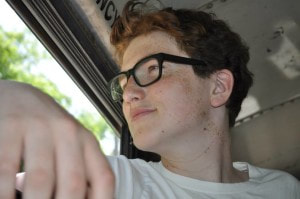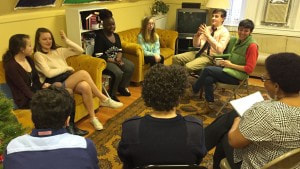|
In last week’s blog post we introduced you to Akia: a high school junior, member of BYOP (Baltimore Youth Organizing Project), and organizer of a recent youth-led mayoral candidate assembly. We mentioned that in their efforts to organize this assembly, BYOP met with youth from Brown Memorial Presbyterian and invited them to attend the assembly. This week, meet Nick: a Brown Memorial youth who attended the assembly and spoke with us about his perspective on it, the relationship with BYOP, and the work still to be done in Baltimore. Tim Hughes, the youth pastor at Brown Memorial, said that the idea of bringing these two groups of youth together was sparked last spring during the Baltimore Uprising that began after the death of Freddie Gray. He said, “On the day of the uprising, I actually got onto my fire escape and climbed up onto the roof of my building. I realized that if I looked to the west, I could see the smoke from the fire where the CVS was burning, and if I looked to the east, I could actually see the steeple of our sanctuary. As I looked at that distance, I just thought that that space between them represents the space we so often feel in these mainline protestant churches where we care about mission and we want to be a part of justice, but it’s hard to figure out how to bridge that gap.”
” The youth from BYOP are “low-income, African-American teenagers who live in the neighborhood of Sandtown-Winchester, which is where the Baltimore Uprising happened.” Brown Memorial is located only about a mile away in the neighborhood of Bolton Hill. “Bolton Hill is the second saftest police district in the city of Baltimore. Sandtown-Winchester is the most dangerous police district in the city of Baltimore.” Tim told YMCo, “There are some obvious differences between our two groups in terms of race and class and neighborhood and the experiences of [their] schools.” He said that as he talked with the youth about BYOP’s visit, the question became, “Why should we be having this conversation with you? Why is it a good idea for us to be in relationship with one another?… The answer was, essentially, that we are a much more powerful group when we work together, and acknowledging that there is a sort of power in the privilege that the white kids have, but there’s also a power in the stories and experiences of the kids that are in the affected neighborhoods, and when you put those two things together, it attracts a lot of attention from the media and the politicians.” Nick told us that this meeting during their Sunday School hour was his favorite part of the whole experience between Brown and BYOP. He said, “I enjoyed that they ran it. It wasn’t like they were our guests and had to listen to us, but that they were telling us what they needed from us. That was a shift in the power dynamic that I enjoyed…Also, we split up into small groups where there was one BYOP representative with 3 or 4 kids from Brown, so we were able to have discussions about our own communities in a way that I thought was really candid and really productive.” Tim said, “Both groups were very nervous about this conversation because it required them to talk directly about the differences of race and class that separate them, but what happened is it was a very powerful and energizing conversation.”
assembly. Nick said that on the day of the assembly, he was both excited about the racially diverse group of youth sitting on the stage, but also disappointed in the segregation that still ended up happening. He said, “In the wake of the uprising there’s been a lot of discussion about how there are two Baltimore’s…so it was an image that maybe challenged that perception, or at least was moving in a way that could try to reduce the heavy boundaries that exist between that. At the same time…there was a clear racial segregation in where the people were sitting because the Brown Memorial kids sat with the Brown Memorial kids and the BYOP kids sat with the BYOP kids. Even within that image of a racially diverse group of people behind the candidates, there was still racial segregation, which is kind of how any racially integrated event I’ve been to in Baltimore ends up becoming. In that way, it was clear that there is still that inherent racial division.” Our conversation with Tim reflected those sentiments as well when he said, “I think both of our groups would say, ‘This has been really powerful to be a part of, but we’re really just scratching the surface of what it means to be in relationship.'” Clearly, there is still work to be done, not only in Baltimore but in our communities all over the nation. The work that Brown Memorial and BYOP have begun is important, though, and gives us hope for a more racially diverse and integrated future. What can you do in your community to engage in these same types of conversations? How can your youth group bridge the gaps of race and class in your own communities? What are they already doing to make this happen? Let us know at [email protected]! If you want to learn more about Brown Memorial and BYOP’s work, check out this presentation Tim and Gwen Brown (BUILD organizer) gave at the 2016 NEXT Church conference, and this promo video with images of their Baltimore community. We’ve also created a study guide for you to use in engaging your youth in these boundary-breaking conversations. Check it out here!
0 Comments
Leave a Reply. |
Archives
July 2024
Categories |
Youth Mission Co
Contact UsPO Box 2988
Asheville, NC 28802 (828 )231-4635 Mon - Fri 9 am - 5 pm EST |
SIGN UP FOR YMCO NEWSLETTER |
© Youth Mission Co. All rights reserved.


 RSS Feed
RSS Feed
